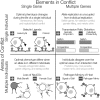Biological roles of glycans
- PMID: 27558841
- PMCID: PMC5884436
- DOI: 10.1093/glycob/cww086
Biological roles of glycans
Abstract
Simple and complex carbohydrates (glycans) have long been known to play major metabolic, structural and physical roles in biological systems. Targeted microbial binding to host glycans has also been studied for decades. But such biological roles can only explain some of the remarkable complexity and organismal diversity of glycans in nature. Reviewing the subject about two decades ago, one could find very few clear-cut instances of glycan-recognition-specific biological roles of glycans that were of intrinsic value to the organism expressing them. In striking contrast there is now a profusion of examples, such that this updated review cannot be comprehensive. Instead, a historical overview is presented, broad principles outlined and a few examples cited, representing diverse types of roles, mediated by various glycan classes, in different evolutionary lineages. What remains unchanged is the fact that while all theories regarding biological roles of glycans are supported by compelling evidence, exceptions to each can be found. In retrospect, this is not surprising. Complex and diverse glycans appear to be ubiquitous to all cells in nature, and essential to all life forms. Thus, >3 billion years of evolution consistently generated organisms that use these molecules for many key biological roles, even while sometimes coopting them for minor functions. In this respect, glycans are no different from other major macromolecular building blocks of life (nucleic acids, proteins and lipids), simply more rapidly evolving and complex. It is time for the diverse functional roles of glycans to be fully incorporated into the mainstream of biological sciences.
Keywords: biological roles; evolution; glycans.
© The Author 2016. Published by Oxford University Press. All rights reserved. For permissions, please e-mail: journals.permissions@oup.com.
Figures







Update of
-
Biological roles of oligosaccharides: all of the theories are correct.Glycobiology. 1993 Apr;3(2):97-130. doi: 10.1093/glycob/3.2.97. Glycobiology. 1993. Update in: Glycobiology. 2017 Jan;27(1):3-49. doi: 10.1093/glycob/cww086. PMID: 8490246 Free PMC article. Updated. Review.
References
-
- Fiedler K, Simons K. 1995. The role of N-glycans in the secretory pathway. Cell. 81:309–312. - PubMed
-
- Lasky LA. 1995. Selectin–carbohydrate interactions and the initiation of the inflammatory response. Annu Rev Biochem. 64:113–139. - PubMed
-
- Nelson RM, Venot A, Bevilacqua MP, Linhardt RJ, Stamenkovic I. 1995. Carbohydrate–protein interactions in vascular biology. Annu Rev Cell Biol. 11:601–631. - PubMed
-
- Rudd PM, Woods RJ, Wormald MR, Opdenakker G, Downing AK, Campbell ID, Dwek RA. 1995. The effects of variable glycosylation on the functional activities of ribonuclease, plasminogen and tissue plasminogen activator. Biochim Biophys Acta Protein Struct Mol Enzymol. 1248:1–10. - PubMed
Publication types
MeSH terms
Substances
Grants and funding
LinkOut - more resources
Full Text Sources
Other Literature Sources

